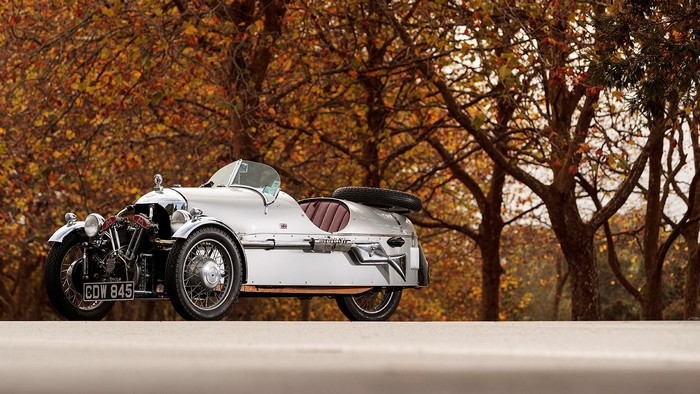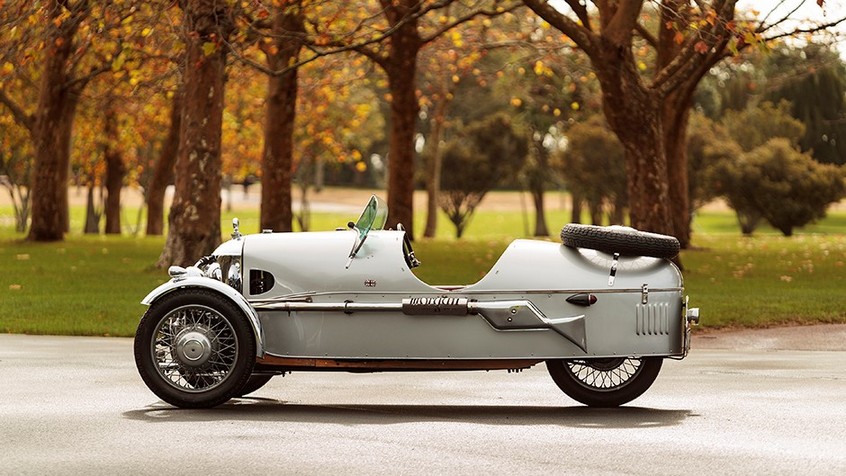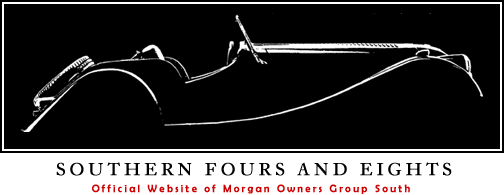1933 MORGAN SUPER SPORTS – MATCHLESS MORGAN (Autocar NZ – July 2019)

WHEN ALLAN DUFFY SEARCHED FOR A CAR THAT WAS OLDER THAN HE WAS, A 1933 MORGAN SUPER SPORTS THREE-WHEELER SEEMED TO MAKE THE MOST SENSE
Once, all car companies were like the 110-year-old Morgan Motor Company, a small family-owned affair pumping out a few hundred cars each year. Yet while contemporary early 20th Century garage-land start-ups like Ford and Morris grew to become huge multinational corporations, Morgan remained pretty much the same for more than a century.
Heck, it even still uses wood to frame the bodywork on the cars that it builds today, the chassis stiffness handled by the steel backbone that has also defined the brand since 1909. So Morgan isn’t just a survivor of a once mighty British motor-manufacturing empire, it’s also a preserver of tried-and-tested construction methods, finest craftsmanship, and a relaxed attitude to production targets.
In good years, the number of Morgans produced by the company’s 170 employees approaches 1000 units, but the customers ordering those cars could sometimes wait up to six years before taking delivery. As with a certain brand of cheese, it appears that good things take time. It was this company culture that inspired Allan Duffy’s purchase of this beautiful beetle-back 1933 Morgan Super Sports.
“Back in 1998, when I turned 50, I was looking to buy a car that was older than I was, but while searching books of all the cars made before 1948, I decided that most of them were rubbish. “Then I came across Morgan – I hadn’t heard of them before.” The distinctive Super Sports tri-car is arguably the Morgan that instantly springs to mind whenever anyone thinks of the Malvern Link-based company, especially the prettier ‘beetle-back’ version, with its gracefully-tapered tail and frivolous cooling gills.
The other body style for the SS trike is the ‘barrel-back’, which looks like some backyard mechanic has rudely grafted a beer keg to the rear of the car.

The latter offers the same token luggage stowage, but it comes at considerable cost to the crowd-pleasing visual appeal of a Morgan trike. “I mostly get lots of waves from other drivers when I’m at the wheel,” says Duffy. “The occasional one gives me a look like I’m from another planet.”
THE EXPOSED ROCKERS OF THE V-TWIN’S PUSHROD-ACTIVATED VALVETRAIN ARE DOING A FRENETIC DANCE TO THE WHINE OF THE GEARTRAIN DOWN NEAR MY RIGHT KNEE, AND THE EXPLOSIVE EXHAUST PIPES EXITING BEHIND ME.
The Super Sports was a big leap forward for Morgan when it first appeared in 1930. That was 21 years after the debut of the first tri-car, powered by a Peugeot V-twin engine in 1909, and Morgan would commission power-plant supply from a number of other motorcycle engine manufacturers in those two decades, including Anzani, Blackburne, and J.A.P. Duffy says that often it was a question of getting an engine at the right price that led to so many different motors being employed by Morgan.
“It was the key to their survival as a low volume manufacturer for they didn’t have to invest large sums in developing their own mechanical components.” The J.A.P. is considered by some classic car enthusiasts to be the best of the engines, possibly because of the successes of the John Alfred Prestwich-designed engine in racing throughout the 1920s, and its connection to the then premier motorcycle brand, Brough Superior. These longitudinally-mounted V-twin engines all drove the rear wheel through a crude two-speed transmission consisting of two primary sprockets, two drive chains, and two final sprockets. “You simply swapped drive chains to change the gearing.”
With the debut of the Super Sports, Morgan finally moved to something better, with a prop shaft running from the V-twin engine to Morgan’s own gearbox, which boasted three forward gears and, thankfully, a reverse gear. Chain was still used to deliver the torque to the rear wheel, but at nearly an inch wide, it was certainly sized to last. The Matchless V-twin could be purchased in either water-cooled or air-cooled form, with Duffy’s car featuring the bulging water jackets and smooth cylinders of the former.
It has tighter tolerances than the finned version, and the exposed engine is quieter. However Duffy has to constantly monitor the ‘moto-meter’ that is mounted to the top of the chromed twin-radiator surround like a luxury brand mascot. The arrow on the meter can quickly move from ‘cool’ to ‘warm’ to ‘hot’ to ‘boiling’ when driving in city traffic like a barometer warning of the approach of a tropical cyclone. “There’s no water pump or fan; it’s a thermo-siphon cooling system similar to a Ford Model T’s.” Despite this early cooling technology, Duffy has found the Super Sports to be ultra-reliable.
“I can leave it sitting in the garage for ages, then it’ll fire up readily once I put petrol in the tank again, and retard the spark”. Another feature of the Matchless is that it can easily be converted to electric start, something the previous owner of the Super Sports did soon after the car’s arrival in New Zealand from Canada. Duffy says that the Matchless is the equal to the revered J.A.P., having previously owned a 1934 J.A.P.- powered Super Sports.
“There’s very little between them, but I’ve been able to drive this one in some pretty atrocious conditions. “It’s been to some pretty wild n’ wet places (including the notorious Rubber Ducky rally in Taranaki).” Not that you’d know that to look at its immaculate condition. Evidently a restorer in Canada spent 10 years getting this Super Sports to look brand new again. Duffy bought it in 2010 from another Morgan fan, having owned the J.A.P. model for a year.
The Super Sports had been imported to New Zealand in 2004. Duffy invites me to come for a ride in one of the most unique cars in the world. The Matchless fires up readily with an authoritative V-twin rumble as he adjusts the hand throttle and spark timing levers fitted to the steering wheel. I clamber into the passenger seat awkwardly, feeling like a sardine on the packing line of a fish factory. Back in the 1930s, some road testers considered egress and access to and from the Super Sports cockpit to be excellent.
Whatever they were putting in the tea back then, I want some! The V-twin has identical bore and stroke measurements, but delivers grunt like a proper long-stroke British big-bore bike engine, with vibrant torque flooding the driveline as soon as Duffy lets out the clutch. Two well-timed shifts of the crash gearbox later, we’re going 45km/h, a speed where the Morgan no longer requires the two lower gears.
There’s plenty of mechanical drama happening ahead of me. The exposed rockers of the V-twin’s pushrod-activated valvetrain are doing a frenetic dance to the whine of the geartrain down near my right knee, and the explosive exhaust pipes exiting behind me. In my line of sight are the left-wheel motions of the Morgan’s famous ‘sliding pillar’ front suspension.
It was one of Henry Frederick Stanley Morgan’s most brilliant ideas, the independently-suspended front end the key to the accurate and agile steering of Morgan tri-cars through bumpy bends. Feeling calm and relaxed, and living a boyhood dream of a ride in a Morgan tricycle, I glance over at my driver. He has a huge grin on his face as he goes about his work, some of which looks like it requires plenty of practice – such as double-clutching a downshift with the foot clutch pedal and the hand throttle lever while still attempting to turn the car into a corner.
At one point in the drive we have to do a U-turn, and the limited steering lock turns it into a three-pointer despite a wheelbase that is shorter than some professional basketball players. Fortunately the reversing part of the manoeuvre is halted with some efficiency by the Morris Minor-sourced front brakes. “Some people are obsessed with originality, but driving in city traffic requires good brakes, especially in a car that’s as low as this one is.”
It’s not the only limitation to driving a Morgan trike in busy Auckland traffic. The rudimentary engine cooling means it’s better “to keep going than to stop” according to Duffy. He also has to park the tri-car on a flat surface or facing uphill to prevent oil vacating the gearbox.
Duffy is about to list the Super Sports for sale in the global newsletter for Morgan owners; The Bulletin. He says it’s simply because he owns two other four-wheeled Morgans, and the 1981 4-4 is better at driving around town than the tri-car, while the Rover V8-powered Plus 8 is a consummate open road cruiser.
The Super Sports will cruise at 80-90kmh quite happily, but it can be tiring for both the man and the machine. Duffy prefers to tow it to events such as the Art Deco festival in Napier.“I often have to wait for the crowd gathered around it to clear before I can drive it.”
The company also moved away from the three-wheelers once World War II started, and it was a huge surprise to Duffy when it unveiled the new 3 Wheeler model at the 2011 Geneva Motor Show after a 60-year hiatus from building tri-cars. Powered by a 85kW S&S V-twin, and driving the rear wheel via a five-speed Mazda manual gearbox, the 3 Wheeler can sprint from rest to 100km/h in 4.5 seconds. However, it still features H.F.S. Morgan’s patented sliding pillar front suspension, circa 1909.

Looks like Greg “Toad” Kaufman’s (Canada) former car. He was one of the founders of eMog.
If you don’t own one you’ll never understand.